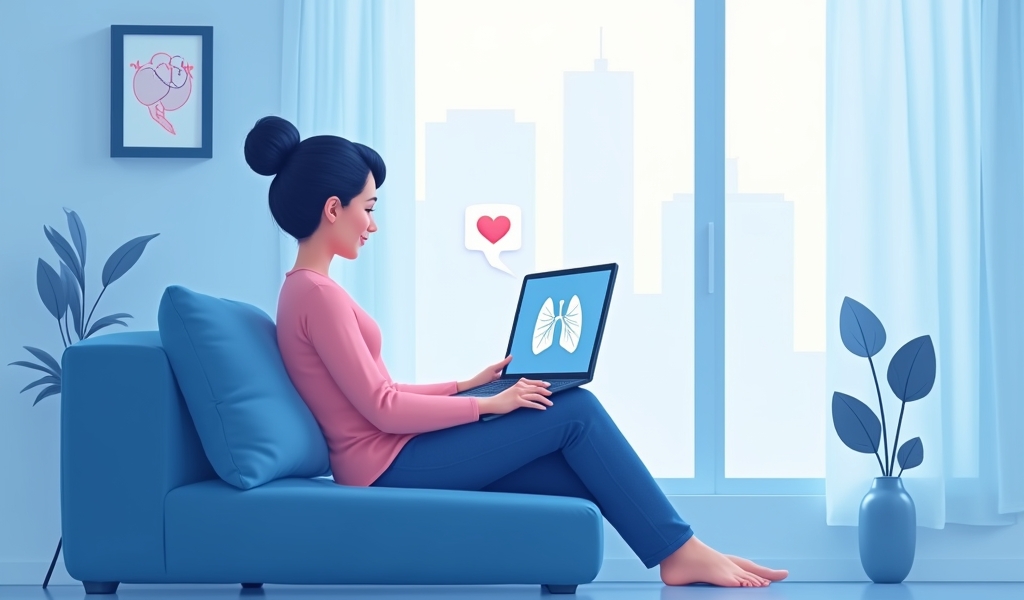Overview
Premenstrual Syndrome (PMS) affects 90% of women of reproductive age, prompting many to seek online resources for managing symptoms as alternatives to in-person doctor visits. The article outlines five evidence-based approaches for online PMS treatment: lifestyle modifications (diet, exercise, sleep), natural supplements, stress management techniques, hormonal balance support, and pain management strategies—all while emphasizing when professional telehealth consultation becomes necessary.
Table of Contents
- Understanding PMS
- Proven Way #1: Lifestyle Modifications
- Proven Way #2: Natural Supplements
- Proven Way #3: Stress Management Techniques
- Proven Way #4: Hormonal Balance Support
- Proven Way #5: Pain Management Strategies
- When to Seek Professional Help
- Conclusion
- Frequently Asked Questions
Premenstrual Syndrome (PMS) affects approximately 90% of women of reproductive age, often disrupting daily activities, relationships, and overall wellbeing. For many women, the monthly arrival of symptoms like mood swings, bloating, and fatigue can feel overwhelming. As our lives become increasingly digital, more women are turning to online resources for managing health concerns, including PMS symptoms. At Dr. Telx, we understand the need for accessible, evidence-based solutions that women can implement at home. This article explores five proven methods to find online PMS treatment without necessarily requiring an in-person doctor’s visit.
Understanding PMS
Premenstrual Syndrome (PMS) encompasses a variety of physical, emotional, and behavioral symptoms that occur in the week or two before menstruation. Common symptoms include irritability, anxiety, breast tenderness, bloating, fatigue, and headaches. While the exact cause remains somewhat mysterious, research points to hormonal fluctuations, particularly changes in estrogen and progesterone levels, as the primary culprit.
Many women initially seek at-home remedies for several reasons: convenience, cost-effectiveness, and a desire to try natural approaches before turning to medications. Fortunately, research supports several effective strategies that can be implemented without a prescription.
Proven Way #1: Lifestyle Modifications
Dietary changes can significantly impact PMS symptoms. Research shows that reducing salt, sugar, caffeine, and alcohol can minimize bloating and mood fluctuations. Instead, focus on:
- Complex carbohydrates (whole grains, fruits, vegetables)
- Calcium-rich foods (dairy products, leafy greens)
- Foods high in vitamin B6 (poultry, fish, potatoes)
- Small, frequent meals to maintain stable blood sugar levels
Exercise has been proven to reduce PMS symptoms, particularly mood-related issues. Even moderate activity like a 30-minute daily walk releases endorphins that combat depression and anxiety. Yoga specifically has been shown to reduce physical discomfort and improve emotional well-being during PMS.
Sleep quality profoundly affects hormonal balance. Establishing consistent sleep and wake times, limiting screen exposure before bed, and creating a cool, dark sleeping environment can all help manage symptoms. Aim for 7-8 hours of quality sleep, especially during the premenstrual phase.

Proven Way #2: Natural Supplements
Several evidence-based supplements show promise for PMS relief:
- Calcium (1,200 mg daily): Multiple studies have demonstrated its effectiveness for mood and physical symptoms
- Magnesium (300-400 mg daily): Helps reduce water retention and may decrease headaches
- Vitamin B6 (50-100 mg daily): May improve mood-related symptoms
- Chasteberry extract: Has shown effectiveness for breast tenderness and irritability
Always consult with a healthcare provider before starting supplements, especially if you’re on medication. Timing matters too—calcium is best absorbed when taken in divided doses with food, while magnesium may be most helpful before bedtime.
If you’re considering supplements as part of your online PMS treatment plan, it’s worth discussing options during an online doctor visit to ensure they’re appropriate for your specific symptoms and health history.
Proven Way #3: Stress Management Techniques
Stress exacerbates PMS symptoms in a well-documented cycle: hormonal changes increase stress sensitivity, while stress worsens hormonal imbalances. Breaking this cycle is essential for symptom management.
Mindfulness meditation has been clinically proven to reduce PMS symptoms. Even 10 minutes daily of focused breathing or guided meditation can make a difference. Apps like Calm, Headspace, and Insight Timer offer specific programs for hormonal health and PMS.
Progressive muscle relaxation, where you systematically tense and release muscle groups, can reduce physical tension associated with PMS. Many free online videos guide you through this technique in just 15 minutes.
According to recent studies, women who practice regular stress management techniques report up to 50% reduction in PMS symptom severity after three menstrual cycles.
Proven Way #4: Hormonal Balance Support
Supporting natural hormonal regulation can minimize PMS symptoms. Consider these approaches:
- Seed cycling: Consuming specific seeds during different phases of your menstrual cycle may support hormonal balance (flax and pumpkin seeds during the follicular phase; sesame and sunflower seeds during the luteal phase)
- Tracking apps like Flo, Clue, or MyFLO help identify patterns in your symptoms and predict when interventions might be most helpful
- Herbal teas containing red raspberry leaf, ginger, or chamomile can provide gentle support
When symptoms persist despite these measures, online medical consultations offer a convenient next step. Women experiencing both PMS and perimenopausal symptoms may benefit from specialized online menopause symptom treatment that addresses the complex interplay of hormonal changes.

Proven Way #5: Pain Management Strategies
For many women, physical discomfort is a primary PMS complaint. Several non-medication approaches show effectiveness:
- TENS units deliver low-voltage electrical currents that can reduce cramping and are available without prescription
- Heat therapy via heating pads or warm baths relaxes uterine muscles and increases blood flow
- Gentle stretching focusing on the lower back, hips, and abdomen can relieve tension
- Acupressure on specific points has been shown to reduce PMS pain
For those requiring medication, over-the-counter options include:
- NSAIDs like ibuprofen or naproxen sodium, which reduce prostaglandins that cause cramps
- Acetaminophen for headache relief
- Diuretics like Pamprin or Midol that address bloating
In some cases, hormonal solutions may offer more comprehensive relief. Many women find that online birth control prescriptions provide not just contraception but also significant PMS symptom management.
When to Seek Professional Help
While at-home remedies are effective for many women, certain symptoms warrant medical attention:
- Severe pain that interferes with daily activities
- Extremely heavy bleeding
- Symptoms of depression, including thoughts of self-harm
- PMS symptoms that don’t respond to self-care measures after 2-3 cycles
Telehealth services make professional consultation easier than ever. During an online appointment with Dr. Telx, you can expect a thorough discussion of your symptoms, medical history, and current management strategies. Your provider might recommend prescription options like hormonal birth control, antidepressants, or diuretics specifically formulated for PMS or its more severe form, PMDD.
Conclusion
Managing PMS effectively often requires a multi-faceted approach combining several of these proven strategies. What works best varies from woman to woman, so don’t be discouraged if your first attempts at online PMS treatment don’t bring complete relief. Track your symptoms and responses to different interventions to create a personalized plan.
At Dr. Telx, we believe that accessible healthcare includes empowering women with information to manage conditions like PMS effectively at home. When self-care isn’t enough, remember that professional support is just a virtual appointment away. By combining evidence-based home remedies with professional guidance when needed, most women can significantly reduce the impact of PMS on their lives and wellbeing.
Remember, your menstrual health is an important part of your overall health—and you deserve solutions that work for your unique body and lifestyle.
Frequently Asked Questions
What is the most effective online PMS treatment available without prescription?
The most effective non-prescription online PMS treatment varies by individual, but a combination of calcium supplements (1,200mg daily), regular moderate exercise, and stress reduction techniques has the strongest evidence base. Many women report significant improvement when implementing all three consistently over 2-3 menstrual cycles. Track your symptoms to determine which approaches work best for your specific PMS pattern.
How quickly can I expect relief from online PMS treatments?
Most natural online PMS treatments require at least two menstrual cycles to show significant benefits. Lifestyle modifications like diet and exercise changes typically take 2-3 months to demonstrate maximum effectiveness. Supplements like calcium and magnesium often begin showing benefits after one complete cycle. Immediate symptom relief is best achieved through targeted approaches like heat therapy for cramping or relaxation techniques for anxiety.
Can online PMS treatment completely eliminate symptoms?
While complete elimination of all PMS symptoms is uncommon, online PMS treatments can significantly reduce symptom severity for most women. Approximately 80% of women with mild to moderate PMS experience substantial improvement with comprehensive lifestyle approaches. For severe PMS or PMDD (Premenstrual Dysphoric Disorder), combining self-care strategies with professional treatment typically provides the most relief. Individual results vary based on symptom severity, consistency with treatment approaches, and underlying health factors.
Is it safe to manage PMS without seeing a doctor in person?
For mild to moderate PMS symptoms, self-management using evidence-based online PMS treatments is generally safe and appropriate. However, certain situations warrant professional medical attention, including: severe pain that interferes with daily functioning, extremely heavy bleeding, symptoms of depression (especially with thoughts of self-harm), or symptoms that don’t improve after trying self-care strategies for three cycles. Telehealth consultations offer a convenient middle ground, providing professional guidance without an in-person visit.
How do hormonal birth control methods work as an online PMS treatment?
Hormonal birth control methods work as PMS treatments by stabilizing hormone fluctuations throughout the month. They prevent ovulation and the subsequent hormonal shifts that trigger PMS symptoms. Different formulations affect women differently—some provide better relief for physical symptoms while others better address mood-related symptoms. Online prescriptions can be obtained through telehealth providers after a virtual consultation to assess your medical history and specific symptom pattern, making this a convenient option for many women seeking symptom relief.

